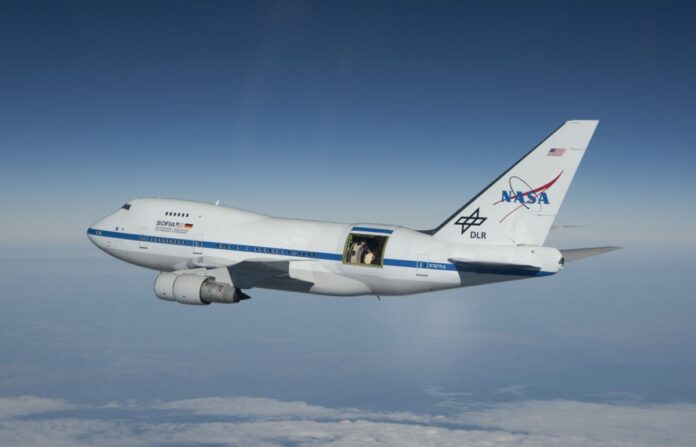The Stratospheric Observatory For Infrared Astronomy (SOFIA) was a telescope mounted on a Boeing 747 SP aircraft that studied infrared light, essentially heat, emitted by objects in the universe. The observatory, fitted with an 8.9-foot-wide (2.7 meters) telescope with a nearly 20-ton mirror, used a door in the side of the aircraft to peer at the sky.
A collaboration between NASA and the German Aerospace Center (known by its German acronym DLR), the SOFIA project was prematurely ended in 2022 after operating for 12 years. The cancellation came following a recommendation of the U.S. National Academies of Sciences, Engineering, and Medicine to discontinue the mission due to its high cost and insufficient scientific return.
Related: NASA’s SOFIA flying telescope spots eclipse of odd binary star
Why was SOFIA on an airplane?
As an infrared observatory, SOFIA needed to be able to view the sky unobstructed by Earth’s atmosphere, which absorbs most of the infrared radiation coming from space. In the 1990s, when SOFIA was proposed, a smaller flying infrared observatory, the Kuiper Airborne Observatory, named after Dutch-born astronomer Gerard Kuiper, had been doing a similar job for about 20 years. An alternative to an aircraft-borne infrared light-detecting observatory would be a space telescope, but at that time, NASA engineers saw considerable technical constraints for such a space mission.
Since infrared telescopes detect heat, they need to be extremely cold in order not to blind their sensors with the warmth they absorb from their surroundings. For example, the European Space Agency’s Herschel Space Observatory, which specialized in the far infrared wavelengths that SOFIA, too, observed, ran out of its helium coolant after only four years in orbit in 2013.
“At that time, there was no other alternative for an infrared observatory that could provide access to the far-infrared universe for a long time,” Alfred Krabbe, a professor of astronomy at the University of Stuttgart in Germany, who oversaw the German participation in the SOFIA mission, told Space.com. “You need something that can return to Earth and get a refill like a car. So the decision to put everything on an aircraft made a lot of sense.”
Alfred Krabbe is a professor of astronomy at the University of Stuttgart in Germany and head of the German SOFIA Institute. He studies centers of active galaxies and their interactions with their environment. He collaborated with Nobel Prize-winning professor Reinhard Genzel on the discovery of helium stars at the center of the Milky Way galaxy, near the black hole Sagittarius A*.
NASA’s James Webb Space Telescope, the current flagship infrared observatory, overcomes the unwanted heat problem with a giant sun shield that protects it from any residual radiation coming from either Earth or the sun. But Webb observes only a small portion of the electromagnetic spectrum that SOFIA could see, the warmer near and mid-infrared light, which has just somewhat longer wavelengths than the optical light that our eyes can see. SOFIA, on the other hand, could detect the much colder far-infrared wavelengths that even Webb is blind to.
At the peak of its mission, SOFIA was making about four 10-hour observing flights per week. When it wasn’t flying, the telescope was in a hangar, allowing engineers to tinker with its instruments, optimize them, upgrade them and also install new ones.
“There is a great advantage to putting instruments up and proving them,” Margaret Meixner, the Director of SOFIA Science Mission Operations at the Universities Space Research Association (USRA), told Space.com. “With some instruments, we kept adding modules and created new science opportunities by doing that. Also, we had an option to fix things that were not performing perfectly well. You can’t do that in a space mission.”
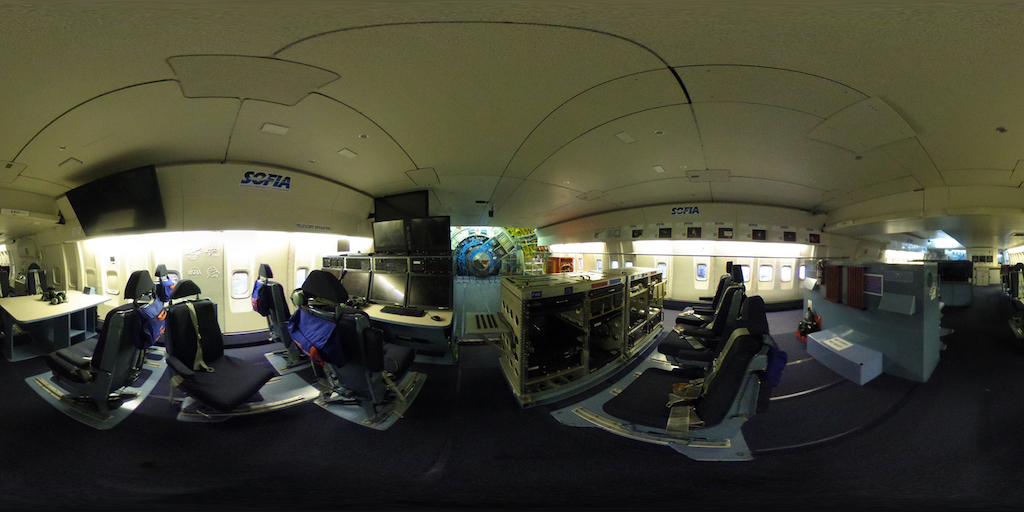
(opens in new tab)
What was SOFIA good at?
SOFIA studied the universe in a vast range of wavelengths. The infrared spectrum covers radiation with wavelengths from 0.75 micrometers at the near-infrared side, which borders with visible light, to 1,000 micrometers at the side that neighbors with microwaves.
The James Webb Space Telescope can detect light with wavelengths from 0.6 micrometers, just at the edge of the visible spectrum, to 28.5 micrometers, where the medium-wave infrared range ends.
SOFIA, on the other hand, was able to detect light in wavelengths from 5 to 612 micrometers, way into the far-infrared range, in which cooler material in the universe shines. While not able to see as far as the famed Webb, SOFIA could discern types of phenomena in the universe that no other observatory could resolve.
“Many galaxies emit most of their radiation in this very wavelength regime,” Krabbe said. “Most of the dust that’s created by active galaxies radiates at temperatures of 30, 40 or 50 Kelvin [minus 243 degrees C, minus 233 degrees C and minus 223 degrees C] and that’s exactly the type of radiation that no other observatory can observe.”

Margaret Meixner is an American astronomer who served as the Director of SOFIA Science Mission Operations at the Universities Space Research Association. She previously worked at the Space Telescope Science Institute in Baltimore. She has led international teams to study the life cycle of dust in the Magellanic Clouds using the Hubble, Spitzer, and Herschel space telescopes.
Most of this radiation comes from the interstellar medium, the dust, gas and cosmic rays that fill the space between stars inside galaxies. While the James Webb Space Telescope can detect some of the interstellar medium’s radiation, its peak is way outside of the grand telescope’s range, at about 100 micrometers, a wavelength that only SOFIA could see, Meixner said.
On top of that, while the supersensitive Webb, fine-tuned to detect the most distant sources of infrared light in the universe, has to stay completely clear of any bright objects, including the planets of the inner solar system, as well as Earth’s moon, the less delicate SOFIA could safely turn its gaze at some of these bodies and make unprecedented discoveries. In many instances, SOFIA also provided a greater resolution of observed light spectra, the chemical fingerprints of the studied matter, which reveal its chemical composition.
“Our spectrometers were able to pull apart the rainbow, or the spectrum, to a much finer level than James Webb,” Meixner said. “About a factor of 20 better. And that enables you to pull out different species of molecules and atoms that you can’t see with James Webb.”
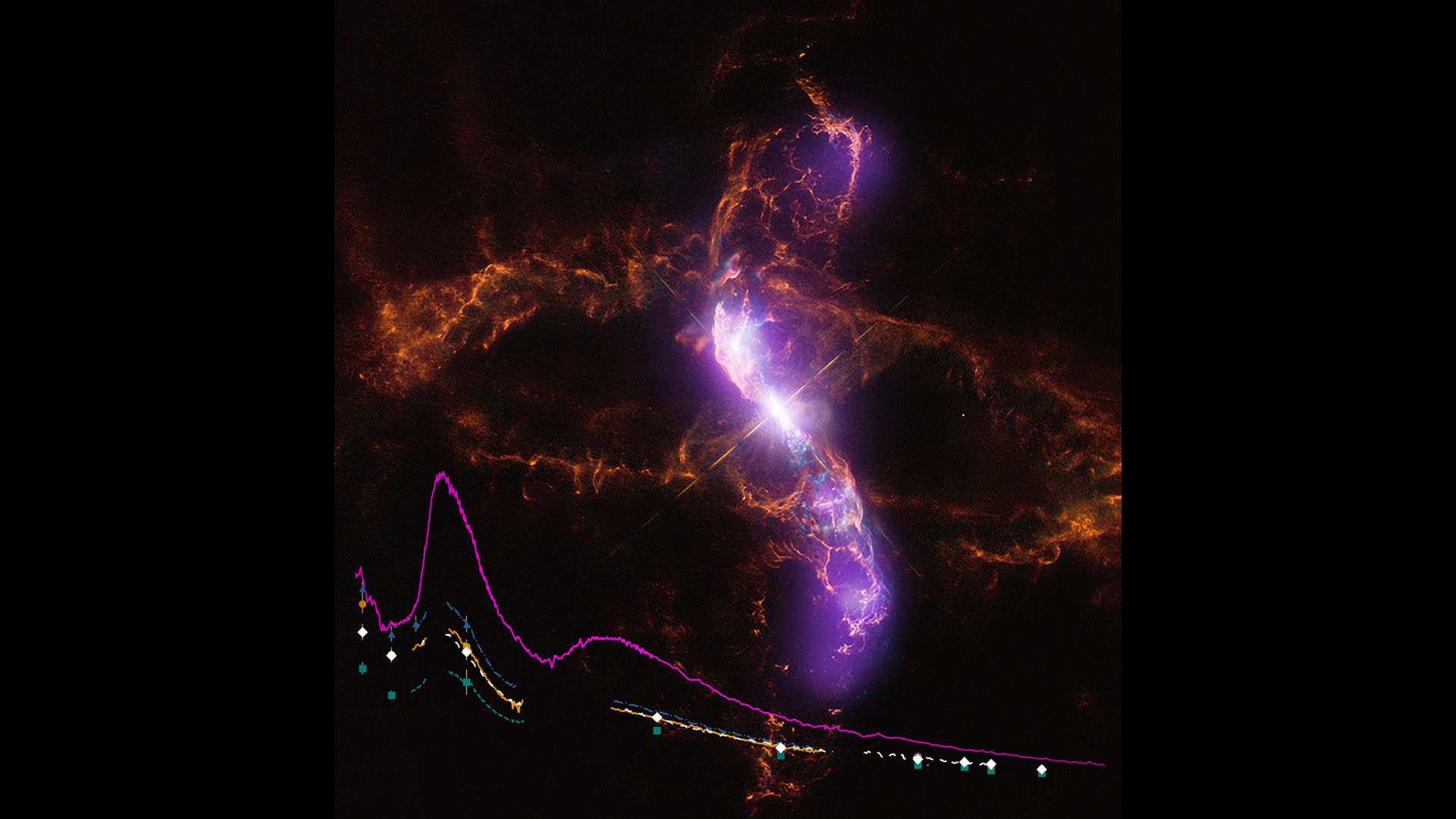
(opens in new tab)
SOFIA’s major scientific contributions
During its 12 years in service, SOFIA, always somewhat in the shadow of its more famous orbital counterparts, made several ground-breaking discoveries. Here are some of the finds that SOFIA mission experts are most proud of.
1. Observations of the center of our galaxy, the Milky Way
The center of our galaxy, the Milky Way, is shrouded in dust, which means that telescopes detecting visible light have no chance of seeing through to the supermassive black hole that resides there. The heat-carrying infrared light, however, penetrates through dust, allowing astronomers to take a look at the strange processes in this fascinating part of the galaxy.
Images published in 2020 revealed a 600-light-year wide area surrounding the Milky Way’s central supermassive black hole, known as Sagittarius A*, in the greatest detail ever, capturing swirls of dust and gas falling toward its demise inside of it.
“It was not possible before to study the interaction between the black hole and the environment around it,” Krabbe said. “We made a lot of progress in this area. The Milky Way’s galactic center is a laboratory that enables us to understand these interactions much, much better.”

2. Imaging magnetic fields that control star formation in galaxies
SOFIA was the first space telescope capable of measuring the direction of magnetic fields on large scales, Krabbe said. It did so by detecting polarization, the direction in which light waves oscillate.
“This was a real breakthrough,” said Krabbe. “It’s very difficult to measure polarization, especially in other than infrared wavelengths.”
For the first time, astronomers were able to observe how magnetic fields affect the behavior of matter across entire galaxies, influencing the galaxies’ rotation and controlling star formation inside thick dust clouds.
According to Meixner, SOFIA’s measurements helped to crack questions that puzzled astronomers for decades. By measuring magnetic fields not only in our galaxy, the Milky Way, but also across many nearby galaxies, for example, SOFIA revealed how magnetic fields frequently counteract gravity, sometimes slowing down and sometimes speeding up the star-formation process.
“Astronomers knew that there must be something slowing down star formation, because we don’t see as much star formation as we would expect based on gravity,” Meixner said. “And SOFIA has actually provided data to make people think hard about what magnetic fields are doing to the star-formation process. They are not just slowing it down. When a dust cloud reaches super high density, the magnetic field actually reverts its direction and allows the gas to feed in and build the star. SOFIA was able to map magnetic fields across whole galaxies and see how they aligned with the galactic spiral arms.”
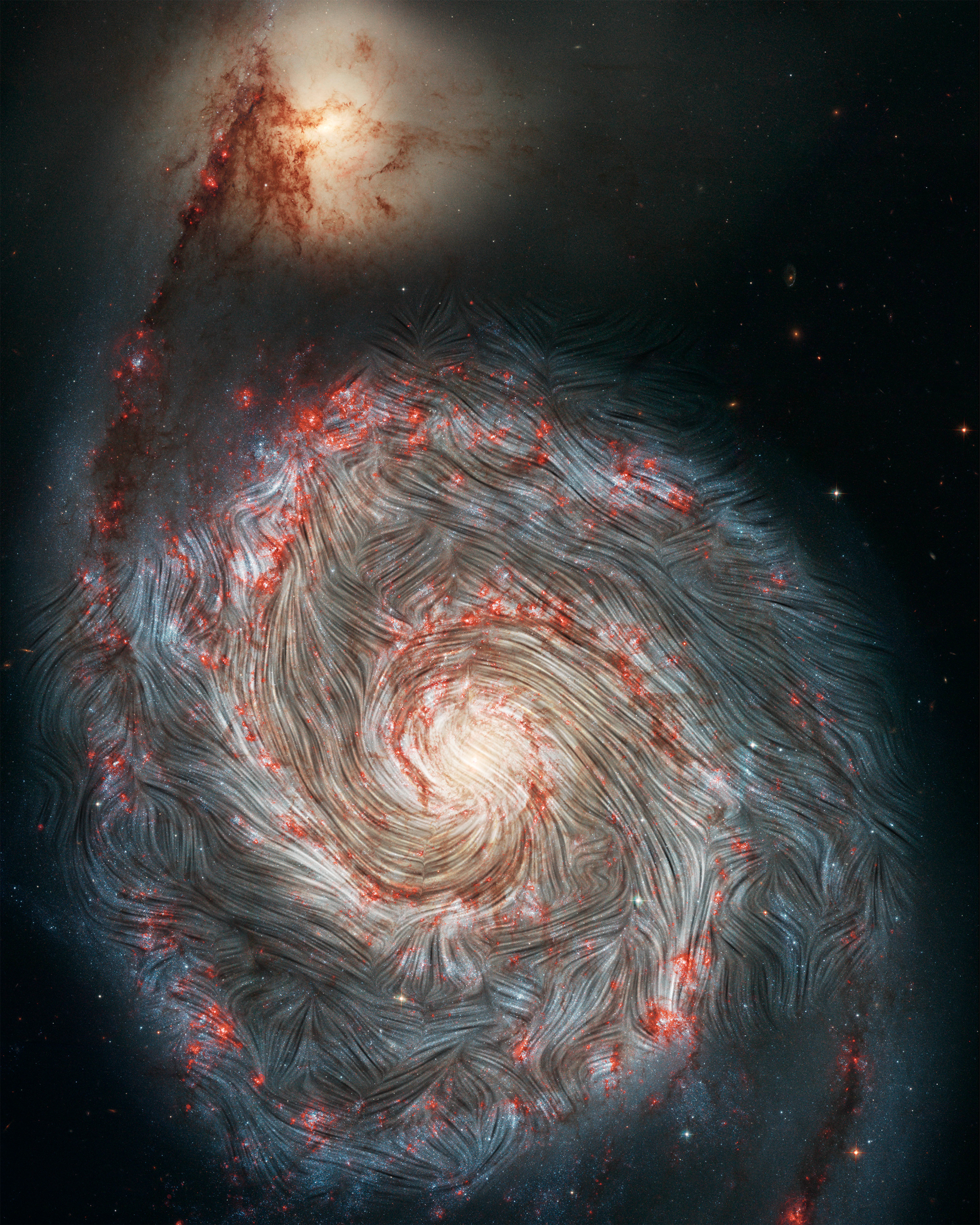
3. Finding water on the moon
Among SOFIA’s most hailed accomplishments is the discovery of water on sun-exposed parts of the moon. This couldn’t have been done by any ground-based telescope, as the signature of water would be completely blocked out by water vapor in Earth’s atmosphere. The James Webb Space Telescope will never be allowed to look at the moon, as that would mean looking in the direction of the sun, the brightness of which would blind Webb’s sensitive optics.
Prior to SOFIA’s exploration, scientists thought that water was present only inside the moon’s permanently shaded polar craters. But the flying telescope’s observations revealed that the life-giving liquid might be much more common on Earth’s companion than previously thought.
4. Ruling out the presence of the potential biomarker phosphine on Venus
The highly sensitive SOFIA also weighed in on the discussion about the presence of phosphine in the clouds of Venus. A 2020 study based on measurements from the ALMA telescope in Chile famously claimed that microorganisms might be inhabiting the turbulent sulfur-rich atmosphere of the scorching planet, because the telescope spotted apparent traces of phosphines.
These sulfur-rich compounds are present on Jupiter and Saturn as a result of the planets’ natural chemistries. However, there was no explanation for their presence on Venus. On Earth, phosphines can be found too, but they have biological origins here. The discovery of phosphines on Venus therefore made headlines all over the world, as it was seen as a possible indication of the existence of life. But SOFIA, with its superior sensitivity, helped quash the excitement two years later.
The telescope didn’t detect any sign of phosphine on Venus, according to a study released in November 2022. That meant that if there indeed was any phospine on Venus, it would have to be present in amounts much lower than the original estimate.
NASA added that SOFIA’s “high spectral resolution also enabled [the telescope] to be sensitive to phosphine at high altitudes in Venus’ atmosphere, about 45 to 70 miles (about 75 to 110 kilometers) above the ground — the same region as the original finding — with spatial coverage across Venus’s entire disk.”
5. Finding evidence of universe’s early chemistry
In 2019, SOFIA made headlines by detecting a long-sought molecule known as helium hydride, which was speculated to have been the first molecule that formed in the universe after the Big Bang.
A combination of helium and hydrogen, helium hydride was eventually detected by SOFIA in a planetary nebula (a remnant of a sun-like star) some 3,000 light-years away from Earth.
For hundreds of thousands of years after the Big Bang, the universe was too hot and too full of radiation for atoms to bond together. At that time, only a few types of atoms existed, including hydrogen, helium and lithium. SOFIA was able to prove that, 100,000 years after the Big Bang, the universe cooled enough for helium and hydrogen to combine, forming helium hydride.
The scope of SOFIA’s wavelength coverage allowed the telescope to track other important chemical elements in the interstellar medium, including a molecule known as carbon plus, which plays a role in the formation of stars.
“SOFIA has done a lot of very interesting work where they’ve mapped out carbon plus in galaxies, how much is coming from star formation versus the general diffuse interstellar medium,” Meixner said. “Along with that, it mapped photodissociation regions, where you have massive stars illuminating their cradle and creating stellar feedback, influencing the chemistry of the molecular cloud that they formed in.”
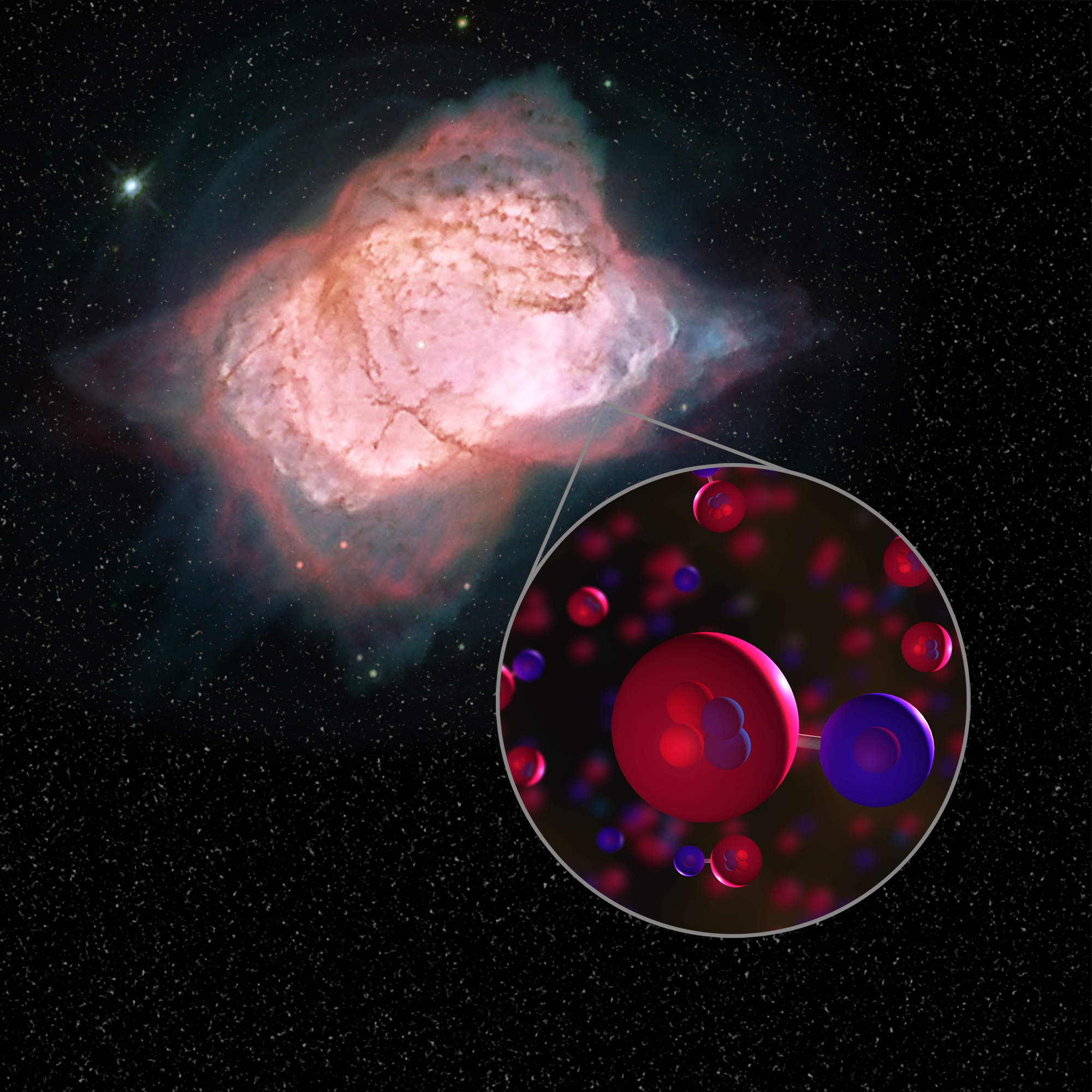
6. Discovering Pluto’s hazy atmosphere
SOFIA’s observations, combined with data from the New Horizons probe’s 2015 flyby of Pluto, confirmed that this cold and dark dwarf planet is shrouded in a hazy atmosphere.
SOFIA made the observations of Pluto during a campaign in which the aircraft virtually chased the dwarf planet’s shadow across the Pacific Ocean during an event known as occultation. Occultation, or eclipse, takes place when a smaller celestial body, in this case Pluto, positions itself between the observer and a more distant source of light, in this case a bright star.
SOFIA observed the middle layers of Pluto’s atmosphere, detecting traces of methane, nitrogen gas and carbon dioxide as high as 20 miles (33 km) above Pluto’s surface. New Horizons then confirmed the observations, capturing beautiful snaps of the blue-tinged atmosphere surrounding the dwarf planet.
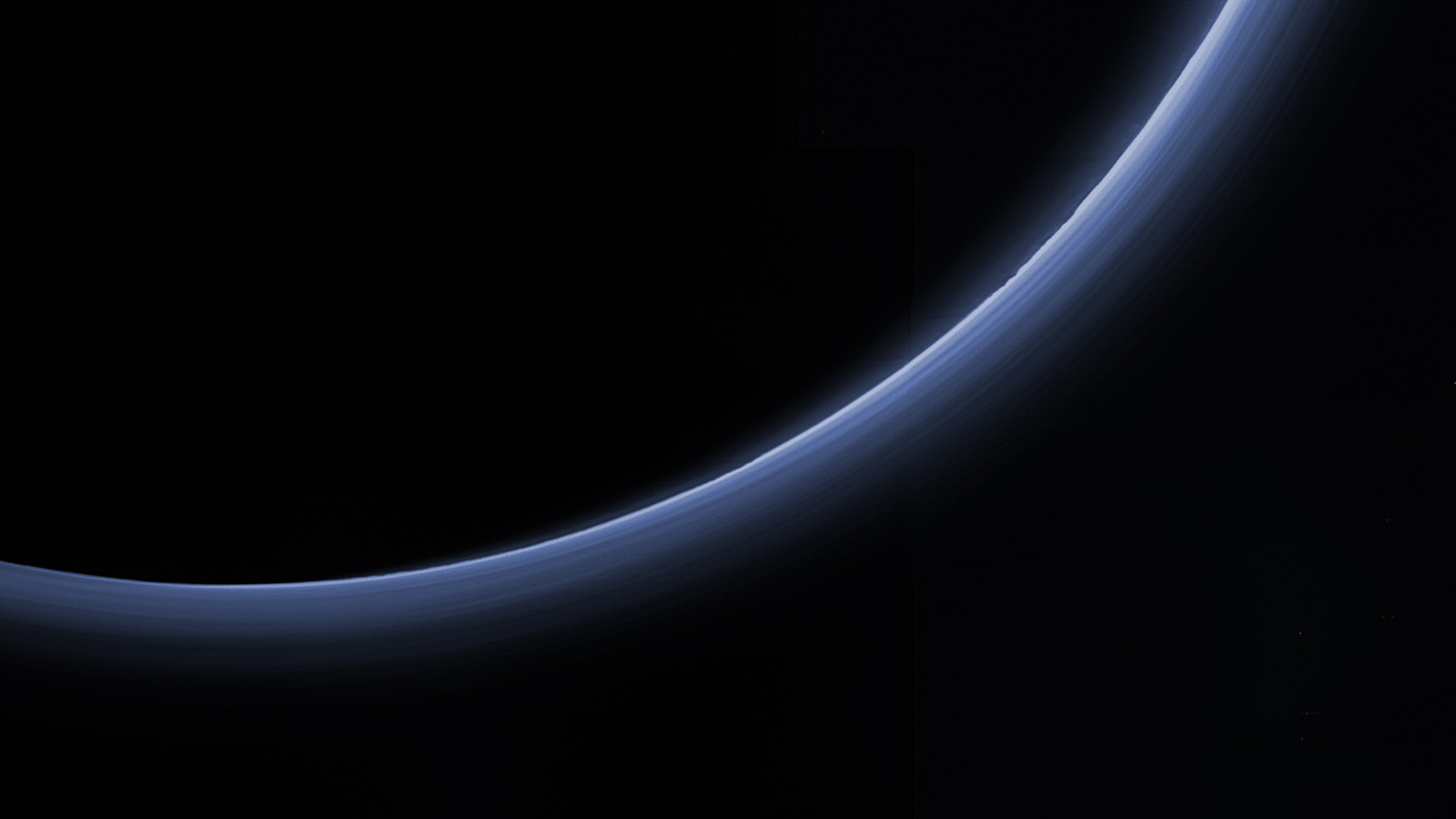
What did a typical observing day with SOFIA look like?
SOFIA was mostly stationed in California but also conducted regular observing campaigns from New Zealand and Germany. Cruising at altitudes between 40,000 and 44,000 feet (12,000 to 13,000 m), above more than 99% of the infrared-scattering water vapor in Earth’s atmosphere, the telescope conducted up to four 10-hour observing flights a week.
Fitted with a lot of intelligent technology to keep it still even as the plane bobbed and vibrated, SOFIA’s 8.9-foot (2.7 m) telescope remained fixed on the observed target while instrument operators, scientists and data analysts sat in the cabin, which was converted into a control room.
The flight crew and navigators occupied the plane’s upper level and the front of the plane, which provided seats for takeoff, landing and enjoying the view.
“In the Southern Hemisphere, you get to see the lights of the aurora,” Naseem Rangwala, the NASA SOFIA project scientist, told Space.com in an earlier interview. “It’s an amazing experience.”
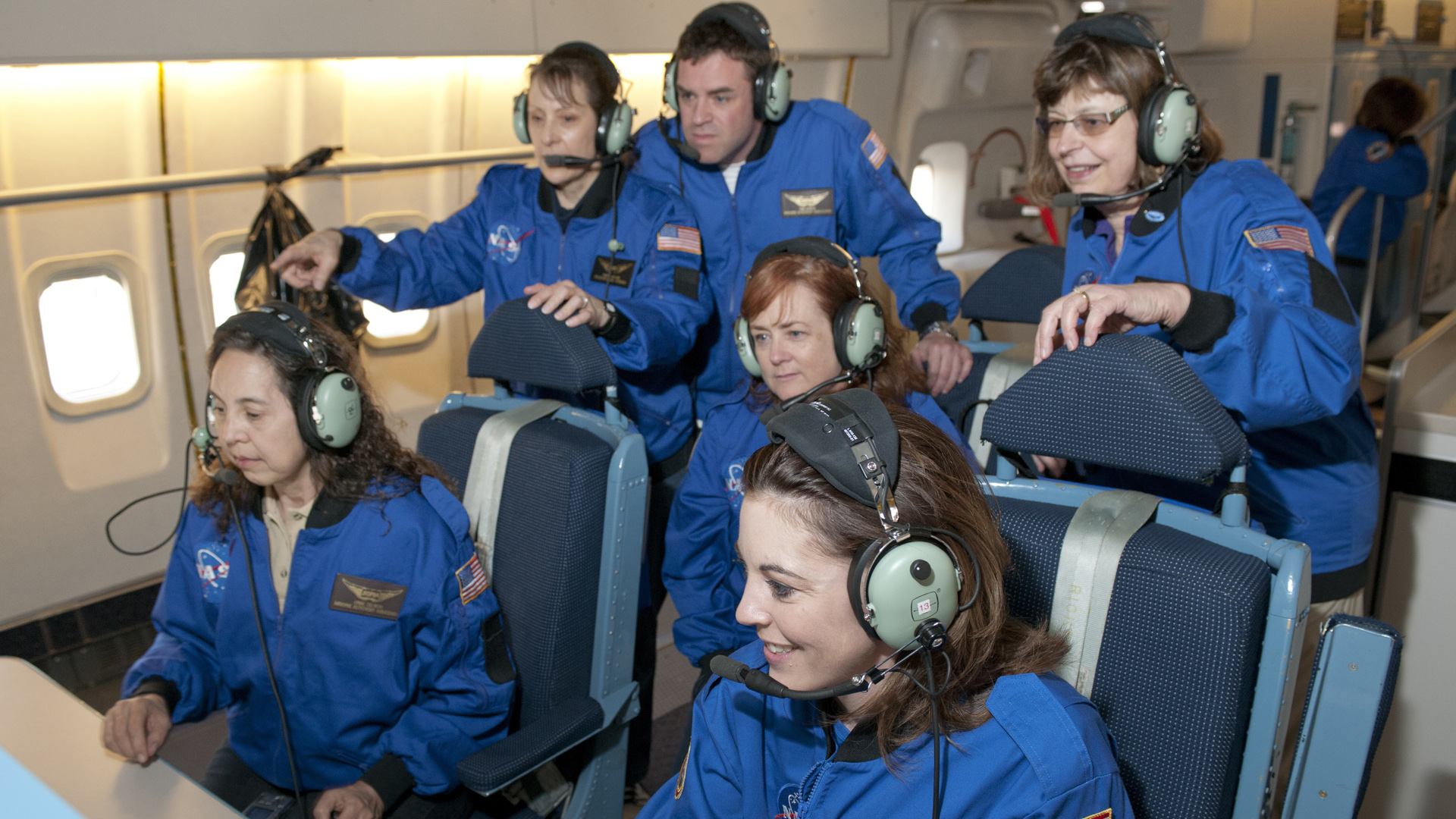
Why was SOFIA prematurely canceled?
The U.S. National Academies of Sciences, Engineering, and Medicine recommended in its “decadal survey” in November 2021 the cancellation of the SOFIA project due to its high cost and relatively low scientific return. Even with its four 10-hour weekly flights, SOFIA couldn’t compete in scientific productivity with space telescopes or ground-based instruments operating 24/7. At the same time, the SOFIA mission came with a surprisingly high price tag.
“SOFIA was the second-most expensive [mission] in the portfolio. Only the Hubble Space Telescope was more expensive,” Paul Hertz, senior advisor in NASA’s Science Mission Directorate and former SOFIA program scientist, told Space.com. “When SOFIA was recommended in 1990, it was recommended on the assumption that it could be done inexpensively. And that turned out not to be true. It cost about four times as much as people estimated that it would cost to build and two or three times as much to operate.”

Paul Hertz is an American astronomer who currently serves as Senior Advisor and Associate Administrator of NASA’s Science Mission Directorate. Prior to his appointment, he worked for over 10 years as director of the Astrophysics Division in the Science Mission Directorate at NASA. Under his leadership, NASA launched the James Webb Space Telescope, began development of the Nancy Grace Roman Space Telescope, continued launching Explorer missions including NuSTAR, NICER and TESS, and initiated the Pioneers astrophysics smallsat program.
At the same time, Hertz added, the mission “was among the least scientifically productive in the portfolio, based on the number of papers produced from SOFIA’s observations.”
SOFIA’s premature retirement, however, leaves a large gap in astronomers’ abilities to observe the universe, which Krabbe said will not be filled for at least 10 years.
“Advances in astronomy come mostly from the fact that you study across various wavelengths,” Krabbe said. “And for the foreseeable future, we don’t have a far-infrared mission, and we may not have one in the next 20 years. For a lot of scientists, this is not an easy gap to bridge. Particularly the young people will turn to other fields and less to far infrared, which I think is unfortunate.”
Meixner said the cancellation came just as SOFIA was reaching its optimal performance and was promising to increase the rate of discoveries and scientific publications.
“In the past couple of years, we have really ramped up the science productivity of SOFIA. We doubled the annual publication rate over three years, and if it was left to continue, we could have doubled the [data] archive over the next three-year period,” said Meixner. “You could say the mission ended on a high point. It hit all records: most flights, the best annual publication rate. I think people were disappointed because they thought that we’ve just hit the stride.”
SOFIA’s cancellation probably closes the chapter of aircraft-mounted telescopes, Hertz said. In the future, however, smaller observatories may be installed on a next generation of autonomous high-altitude balloons or UAVs.
“There may be niches for small airborne astronomical observatories in the future,” Hertz said. “But when it comes to major infrared missions, the decadal survey recommended a space probe that would do a lot of the science that was unique to SOFIA, would cost about as much to build as SOFIA cost, but would be much more scientifically productive.”
Where is SOFIA now?
SOFIA’s final flight took place on Dec. 13, 2022. Taking off from NASA’s Armstrong Flight Research Center in California, its usual home, the aircraft didn’t head out above the ocean to escape light pollution and observe distant nebulas and galaxies, however. Its destination was the Pima Air & Space Museum in Tucson, Arizona, where it found its final resting place, or a permanent home, as a museum exhibit.
Additional resources
For an in-depth dive, read the SOFIA Status and Future Prospects report (opens in new tab)released by the SOFIA team just before the mission’s cancellation.
The National Academies decadal survey report, which provided the basis for the mission’s cancellation, can be found here (opens in new tab).
More information can also be found on NASA’s SOFIA mission page (opens in new tab) or on the SOFIA Science Center website (opens in new tab).
Bibliography
Rangwala, N. et al. SOFIA: Status, Future and Prospects, USRA, March, 2023
https://www.sofia.usra.edu/sites/default/files/2022-03/SOFIA_Status_Future_Prospects_17Mar22.pdf (opens in new tab)
National Academies of Sciences, Engineering and Medicine, Pathways to Discovery in Astronomy and Astrophysics for the 2020s, Nov. 4, 2021
https://www.nationalacademies.org/our-work/decadal-survey-on-astronomy-and-astrophysics-2020-astro2020 (opens in new tab)
NASA, SOFIA
https://www.nasa.gov/mission_pages/SOFIA/overview/index.html (opens in new tab)
Universities Space Research Association, SOFIA Science Center
https://www.sofia.usra.edu/ (opens in new tab)
Follow Tereza Pultarova on Twitter @TerezaPultarova. Follow us on Twitter @Spacedotcom and on Facebook.
